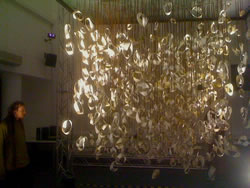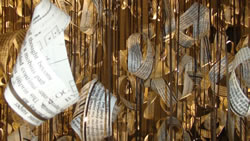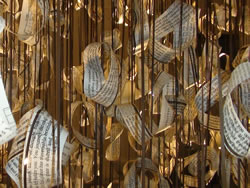Suspended Imprints
An Exploration of space, sound and the inner monologue
This paper was presented at the Toronto Electroacoustic Symposium 2010, during the Cognition, Interpretation and Analysis session, chaired by Michael Kaler.
Introduction and Background

I view sonic art installation as an opportunity to express and explore multiple conceptual nodes and ideas through an immersive audio-physical environment. This article considers my current conceptual research centred on the perceptive processes of the sonic art audience in my recent project Suspended Imprints (2010).
The increasing presence of interdisciplinary artworks can be seen as symptomatic of the pluralism which characterizes the current contemporary arts climate and as a researcher in the field, I have become fascinated with the resultant implications for the identity of the sonic artist and the perceptive processes of their audience. The crux of my research is concerned with the dialogue occurring between the sonic artwork and its audience. It considers the possibility that following a revelatory narrative between self, sonic and physical environments, the artwork becomes redefined within the liminal spaces in which this dialogue operates. It was at this stage in my research that I became interested in the concepts of the inner monologue and the Möbius strip in particular.
The Inner Monologue
Suspended Imprints is resultant of an ongoing artistic exploration into the notion of a personal, inner monologue: the private, communicative vehicle often operating in the mediation between ourselves and the spaces we occupy (whether artistic or otherwise). Could this idea of an internal cognitive narrative be considered a primary facilitator of the dialogue between sonic artwork and the perceptive individual? In terms of phenomenology, it is possible that the inner monologue could be described as “the act of objectivating” (Macann 1993, 16) as a kinetic and expressive articulation of the mediation of our environment along a temporally linear trajectory. Furthermore, when placed in the context of sonic art, the objectivating act (as hypothetically implemented by the inner monologue) is of great significance to my research. As suggested by the philosopher Edmund Husserl, “the objectivating act is the primary bearer of matter” (ibid.): a notion that resonates with the idea that within the process of artistic mediation, an individual makes kinetic the signifying potential held within an artwork. Whilst Husserl discusses the idea of an objectivating act in reference to the physical deliberance of articulated utterance or written text, it may be viewed that his arguments are still applicable to the more ephemeral existence of the inner monologue in this context on account of the deliberate cognition one often employs when invited to consider such interdisciplinary artworks. Also, the inner monologue holds further significance in terms of providing a mediatory outlet between what may be regarded as the physical bodily confines in which it inhabits internally and the exterior art object. If we were to consider Martin Heidegger’s notion that we ourselves extend beyond our own “bodily limits” (Heidegger 1962, 62) then perhaps it could be argued that the inner monologue is an example of this act in real time on a metaphysical level. And so, it is this concept of the inner monologue as an active extension of ourselves beyond the corporeal boundary that I became primarily concerned with during the development of Suspended Imprints.
The Möbius Strip
During the developmental stages of the work, I found a strong connection with these concepts and the topological figure, the Möbius strip, a figure defined by Nathaniel Stern as:
a topological figure that can be produced by twisting a strip of paper and looping and attaching its ends. It is thus a one-sided surface with only one boundary component, which is available in three dimensions. This means that it lives in both 2-D and 3-D space at the same time; it is greater than the sum of its parts. (Stern 2007, 24)
On initial encounter, the structure has an obvious edge or spatial boundary separating the interior and exterior spaces between what appears to be two separate surfaces — much like the boundary provided by our own physical body which allows for an immediate distinction between our personal, internal spaces and the exterior world in which we position ourselves. However, upon closer consideration one ascertains that this boundary — whilst clearly existing — no longer provides a clear distinction between these spaces. The same continuous surface exists in both interior and exterior states, accompanied by a considerable grey area as to when it can be considered one or the other. These topological properties of the Möbius strip have long been popular as a conceptual representation of the body and its relationship with the exterior world, having been exemplified by philosophers such as Lacann, Lyotard and Grosz among others. Resonating further with the concepts explored within Suspended Imprints is the notion that the properties of a Möbius strip are revealed as the result of a linear narrative of investigation. To those unfamiliar with it, what instantaneously appears as two surfaces is revealed as a singular, continuous surface after tracing the spatial trajectory of the material. This could be seen as similar to the connections that occur between our own personal consciousness and the external spaces in which we inhabit, connections that come to exist through lived experience and a conscious, linear narrative of the inner monologue.
Initial Documentation preceeding Suspended Imprints
As mentioned prior, Suspended Imprints concerns the notion that our inner monologue holds a complex relationship with the spaces we occupy, articulating both narrative and spatial pathways as we encounter our environment. As such, the installation itself is resultant of a documentary process in which the immediate thoughts of people traversing a popular thoroughfare in the Creative Arts Building at the University of Huddersfield were recorded on tape. Between the 11th and 16th January 2010 a temporary recording booth comprising of a microphone and a multi-track tape recorder was housed in this space, inviting people to record the thoughts in their head as they passed through the space. Upon completion of this documentary period, the sonic material was converted to a digital format for further processing, whilst the tape itself was used in the installation.
Physical Environment of Suspended Imprints
The installation structure was housed by a 4.5 m³ scaffold from which a large number of Möbius strips were suspended at varying lengths using the magnetic tape from the documentary stage of the work. The strips themselves were constructed from pages of pre-owned topical books, such as architecture and geographical texts. Blueprints of the building itself, transcribed excerpts of the documented thoughts and original conceptual text were also layered onto the strips. As a result, each Möbius strip is unique, containing multiple layers of meaning and multiple ways with which they can be engaged and interpreted. And so, the information displayed on each strip holds previous meaning and previous history but still undertakes new meaning in the presence of a subjective individual.

Sonic Environment of Suspended Imprints
The physical components of the work are sonically paralleled by sounds generated from the documentary stage of the work, creating together a cohesive artistic environment aiming to reach beyond the physical confines of the structure itself. The entire installation space was filled with low, resonant sonic material, evolving in timbre and harmonic density at an almost undetectable rate. Simultaneously, metallic timbres move kinetically within the structure itself, articulating pathways through the space highlighting its visual intricacy. I wanted to create the impression of ephemeral trajectories of sound that appear to exist within — and perhaps become part of — the dense, low resonance encompassing the individual. These high, metallic timbres were achieved by processes of spectral filtering and looping, allowing the dynamic morphologies of the spoken utterance to only just articulate the timbral flux of the material. A Max/MSP patcher was then designed to randomly select these sound files and pan them around the four speakers suspended in the structure, at differing speeds and occurrences allowing for the possibility of both temporal and spatial overlapping. The resonant sonic material was processed using simple techniques such as using low pass filters, compression and modulation. I feel this allowed the sound to contribute equally to the installation, creating an atmospheric parallel of the concepts operating in the physical structure rather than distract the individual from a personal dialogue with the work due to an explicitly transformative narrative in the sound world.


Summary and Future Projects
Originally, the work was designed to be suspended 1.5 m above head height. This would have resulted in a blanketing cloud mass occupying the upper stratum of the installation space, creating the impression of a cascading freefall of Möbius strips suspended in motion, with only some of the strips hanging low enough to be read. It was during the installation process itself that unforeseen health and safety issues with the scaffold forced a loss of 1.5 m in height. As a result, the Möbius strips could no longer be suspended above the audience as previously described. The work was redesigned as a rounded cloud mass of the Möbius strips suspended at eye level. Perhaps the most interesting outcomes of this project have been the questions raised as a consequence of these modifications.
These issues regarding scale, format and their impact on the relationships between the physical and sonic elements of a work and consequently, their dialogue with the sonic art audience have sparked new lines of inquiry in my research. As such, I am currently exploring the role of scale and self in a series of works, each taking the same artistic concepts and material yet manipulating their format in terms of scale and proportion. Theoretically, I am also currently investigating the relationships between semiotics and temporality operating in my own creative practice and how they contribute to a distinctive art experience within sonic art.
Bibliography
Barthes, Roland. “The Death of the Author” Image-Music-Text. Translated by Stephen Heath. New York: Hill and Wang, 1977, pp. 144–148.
Macann, Christopher E. Four Phenomenological Philosophers: Husserl, Heidegger, Sartre, Merleau-Ponty. New York: Routledge, 1993.
Heidegger, Martin. Being and Time. Oxford: Blackwell, 1962.
Smithson, Alan. “Thin Air” (Lecture Notes) Expo Leeds (25–29 September 2009). Leeds.
Stern, Nathaniel. “Implicit Bodies Through Explicit Action.” Perspectives: International Postgraduate Journal of Philosophy 1/1 (2008), pp. 22–42.
Social top